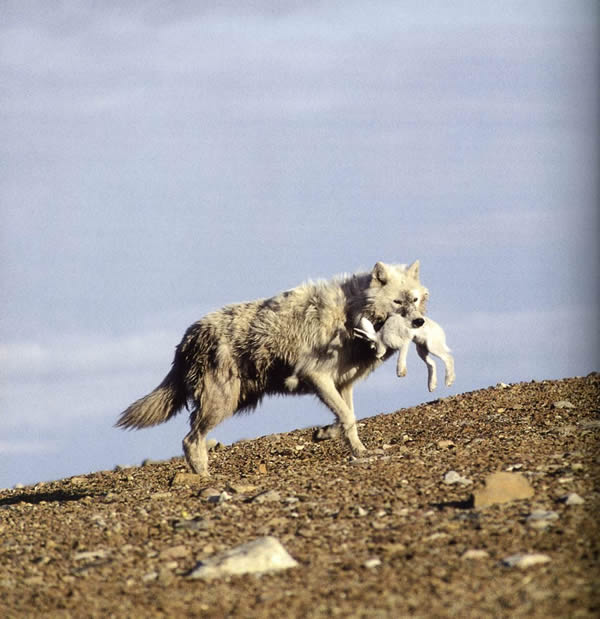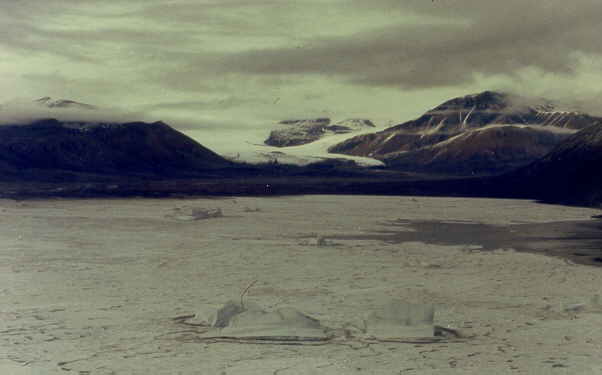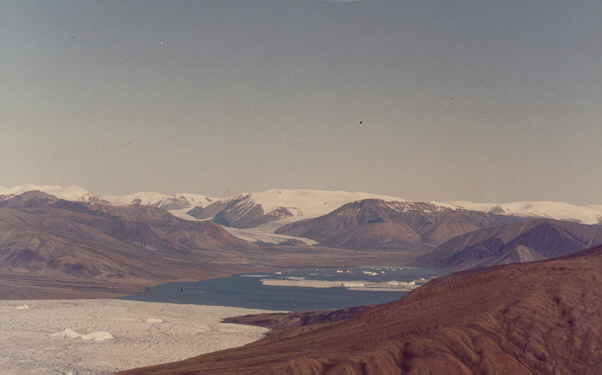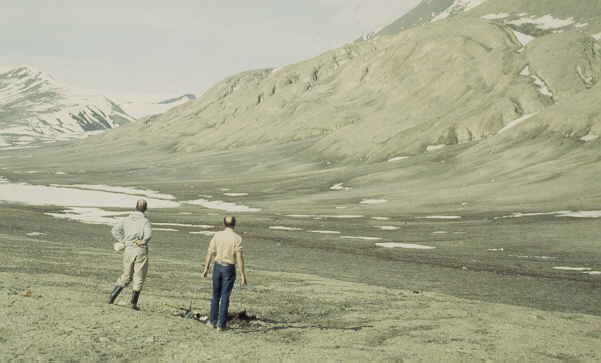
Islay, an Arctic wolf, 5 years old in 2002, kept at home by Jana and Chris from Lake Tahoe, 75% Arctic Wolf and 25% Timber Wolf, 3rd generation. Photo taken in Mammoth Lakes, Sierra Nevada (Click on pictures for full view).
In Northern Canada, on Ellesmere and Axel Heiberg Island, I stood face to face with the Arctic wolves a few times during expeditions in the eighties. I could never take a photograph as they always wandered off right away, keeping a safe distance. Last year, in 2002, I met a domesticated Arctic wolf, Islay, a huge animal, twice the size of a German Shepard. (See California/Nevada 2002, middle)
Wolves are fascinating animals. Wild and strong but also very inteligent. They live in social packs and a lone wolf tends to get killed when it straddels into the territory of another wolf pack when not accepted or pushing out the alpha male or female. In the wild, they always avoid humans as we are the size of a bear, and are difficult to spot.
In 2002, in the Sierra Nevada, I got my first change to closely approach and even touch an Arctic Wolf, the size of a Saint Bernard. The domesticated animal was very friendly and slow moving but has an enormous power. It was a 75% third generation Arctic wolf and 25% Timber wolf, kept by Jana and Chris from Tahoe.
The wolf reminded me of the cross-breed between a husky and Saint Bernard I saw in Resolute Bay in the Canadian High Arctic in 1988. It just had a litter and the pups were for sale. I really wanted to take one home.
In Northern Canada many animals that normally have earth colours like grey, brown or black, are white. This is the right camouflage colour as patches of snow stay in the area for 10-11 months a year. The most well known white animal is the polar bear, but also fox, hares, caribou and even wolves are white. Lemmings and musk-ox have dark colours, also new born hares, as a disguise in the rocky terrain.
Arctic wolves are notably bigger then the grey wolves down south, with long legs and broad paws that enable them to walk on snow. I met wolves several times on Ellesmere and Axel Heiberg Islands and was always impressed. They are the biggest predators next to polar bears. A pack of 2-4 wolves will make a bear to run for its live.
Mahlamut huskies in Siberia, Alaska and Canada are probably cross-breeds with Arctic wolves, see [1].
Despite their size, wolves seem to eat mostly lemmings. They do attack musk-ox although rarely successful as a musk-ox is too large. A fit lone musk-ox bull you find in almost every valley and can easily defends itself. Wolves also try to catch hares but the hares are very fast and the wolves are rarely successful.

Below some engagements I had with white Arctic Wolves in Northern Canada. Photo by Dave Mech, see https://davemech.org/ .
In 1982, we made a camp near Buchanan Lake [1, area on the sea in the far distance], a place known for Arctic Char fish, a kind of salmon that lives in lakes near the sea but feeds in the sea. The valley in front of the mountain range was close to the sea and the main north-south pathway for migrating animals. Every day we saw caribous, musk-ox and occasionally even wolves passing by.
Fishing for Arctic Char in the lake did not work. The fish use the meandering stream to reach the sea for feeding. One unlucky fish resting in a shallow spot we caught by a sledge hammer approach, using a geological hammer. The large 5 kg fish was food for several days.
One night we heard animals outside the tent and were worried it could be a polar bear as we were camped near the sea. Luckily there were just two wolves trying to steal our garbage bag. Still, this would have been a problem as every campsite is inspected after the seasons for trash. We were not allowed to leave any signs of camping in this pristine natural area. Northern Canada is treated as a highly protected national park and the area is very sensitive to human influence.
Firing a shotgun did not work. The wolves just looked at us for a brief moment and kept on dragging the tasty garbage bag along. The only other option I had was firing an emergency flare and now they were gone in a split second. This presumably resembles lightning and all animals are scared of this. Only once I saw a thunderstorm in this area so they are familiar with it.
All animals except polar bears are scared of emergency flares, I have been told. For polar bears we carry the bangers, resembling a flare but when shot making a dual thundering noise at a distance of 100 m. I never had to try this out and would not rely on an effective working. When you have a polar bear in a camp, tends to be a curious male, there is only one option, move camp ASAP.

Strand Fiord in early July, during poor weather. 
Strand Fiord in late July, during good weather.
In 1984, one of my students (Jeff Torrance) and his summer student camped on snow covered Strand Fiord in early July. Within two days Jeffy got into trouble with, most likely, the only wolf of Western Axel Heiberg Island, as we never saw one in that region. We normally store meat in a big aluminium box and put this outside in a snow bank to divert polar bears from the camp and to keep it cold but more importantly, to avoid other animals like foxes and wolves from stealing it. Jeffy instead, put the meat in sample pails in a snow bank and just closed the lid, using the aluminium box for the kitchen utensils, which is very handy; this is how we ship it to keep it clean, but definitely not the idea, it is used for storing the 10 day meat supply.
Within days, a smart wolf got away with all of Jeffy’s meat rations for 10 days and the meat hungry Canadians were royally pissed off. He told me over the radio: "If I spot the damn wolf, I will shoot it", and, "I will hunt it down". I found this funny, being outsmarted by a wolf. We did have a fall back option by having ample cans with salmon and tuna, and fish is more healthy anyway. He could also fry up the delicious "Spam" referring to the unpopular ham cans.
When they moved two weeks later, they left their smelly garbage in a tent at the same site and closed the tent. They should have burned and burried it. When my professor returned to this camp a week later to fly out by Twin Otter, the tent was ripped and the garbage all over the place. They spent a few hours cleaning up the site. The wolves simply tore the strong tent cloth to pieces and spread the garbage around eating only the edible parts.
In 1988, at the Gibbs Fiord anhydrite/salt dome on Eastern Axel Heiberg Island, we passed a wolfs den. This was a large, well used cave the wolves dug out in the soft gypsum (weathered anhydrite) of the anhydrite/salt dome and the outside was littered with bones. My summer student thought this was very interesting and wanted to check it out but I insisted on leaving as soon as possible. Wolf packs in the High Arctic have around 4-6 animals and there could have been cubs in the den.
They may have left a single adult wolf on guard, nearby or inside. We did not carry the heavy shot gun as we were far from the coast. The wolves would have defended the den fiercely on spotting us.
This reminded me of an aggressive German shepherd on a farm in Holland that just had a litter and almost attacked me if it wasn’t for the farmer stepping in. The dog knew me but did have a wild character from living in the woods by itself for a while and was adopted by the farmer only a few months earlier.

North of Hare Fiord. Fried and student watching 4 wolves
(white dots, not visible) that circled the camp for a week.
In 1989, six of us were dropped of North of Hare Fiord on Northern Ellesmere Island on muddy tundra near the shore and luckily the plane did not get stuck [1] but it was a close call, the wheels made deep tracks. A pack of four wolves [white dots in the distance] circled our camp several times in a weeks period. We left a one of the summer students home to guard the tents as they could easily rip up a tent in search of food as happened in 1984 on Strand Fiord when we left garbage inside a tent. They never came close keeping a distance of at least a km all the time; again no pictures. The scenery here is special, frozen sea ice [1], icebergs [1] and glaciers almost touching the sea [1].

Eureka weather station in mid July, sea ice breaking up.
In 1989, one night as I was walking from the Eureka weather station to our camp across the stream, see above, a wolf crossed the dirt road. It looked at me and wandered off, just like a dog showing no interest. National Geographic Channel is regularly showing documentaries of the white Arctic wolves of Eureka that have a den nearby. The cook of Eureka often feeds them with left over food.
See BC story: A young Arctic wolf, cuddling
In the zoo of Amsterdam, called Artis, two Arctic wolves are held in a large double cage connected with an underground tunnel. They tend to hide in the artificial caves and rarely come out.
I saw them only twice in the winter, never during warm spring and summer days, too warm?
Once I saw a lot of white feathers in the cage, they must have caught a sea gull.
Arctic wolf, Artis Zoo, Amsterdam
There is an interesting novel with the title “Never Cry Wolf” by the Canadian author Farley Mowat on the grey wolves in Arctic Canada. It has also been made in a movie but it is really a documentary showing how wolves live. Below a summary of the scene when the biologists is dropped off in the field:
“A biologist is dropped in Arctic Canada in an area were Timber Wolves are believed to have decimated the caribou herds and the government is thinking of setting a bounty on killing wolves in this region. He is dropped of in the Spring on a frozen lake during a cold day and the pilot tells him: “Bye, bye, see you in 6 months”. He hears howling wolf and in the far distance a pack of wolves is approaching, he thinks. Unable to find the ammunition of his riffle in the pile of equipment, he hides under his kayak. Within minutes wild animals are sniffing at his canoe and seem to try to get him. Suddenly he sees two human feet, this was just a dog sledge with huskies.”
You are visitor #
![]() since February, 2003.
since February, 2003.